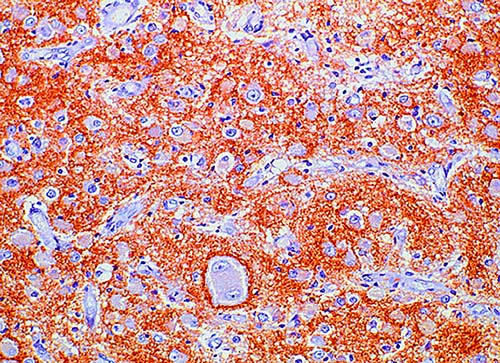Current Research
Surgical and Molecular Neuropathology of Human Brain Tumors
Based on a large number of referrals to The German Brain Tumor Reference Center at the University of Bonn Medical Center, our group has carried out extensive studies on the morphological and molecular characterization of human CNS neoplasms. Critical information has also been derived from therapeutic trials for which the center served as reference neuropathology laboratory.
The 2007 WHO Classification of Brain Tumors, for which the consensus conference was held in Heidelberg in 2006, serves as the international standard for the diagnosis and characterization of nervous system cancers.
 |
| Fig. 1. Ganglioglioma with binucleated neuron and strong immunoreactivity for synaptophysin |
Molecular Neuropathology of Human Gliomas and Medulloblastomas
In cooperation with Andreas von Deimling (Heidelberg) and Torsten Pietsch (Bonn), human gliomas and medulloblastomas have been subjected to a systematic molecular and cellular analysis. The studies yielded important novel insights into molecular pathways in the formation of these tumors some of which have been introduced in the diagnostic repertoire.
In the case of childhood medulloblastomas, a combination of molecular and cell biological experiments made it possible to unravel the origin of these embryonal tumors from distinct cerebellar progenitors and to associate these subtypes with distinct molecular alterations.
Molecular Neuropathology of Epilepsy-associated Neural Tumors
Patients with chronic focal epilepsies often display low-grade neoplasms with distinct morphological and molecular properties. Characteristics include high differentiation, presence of both glial and neuronal components, a potential origin from malformative lesions and a pattern of molecular changes distinct from other CNS neoplasms.

